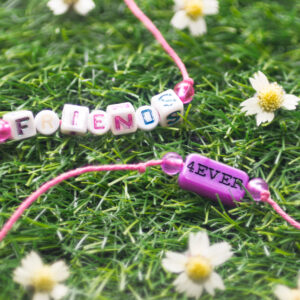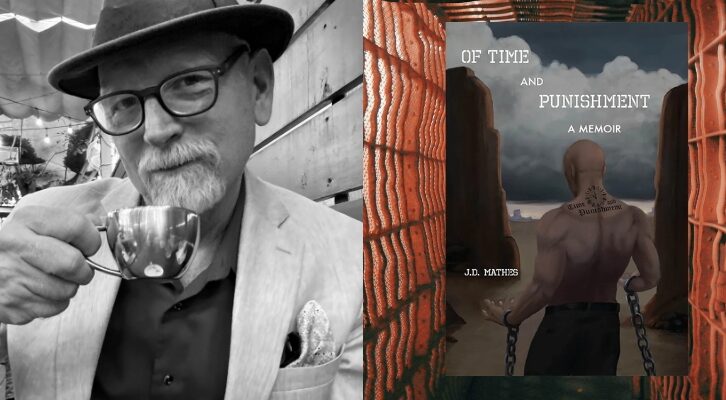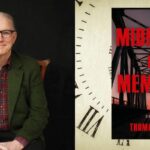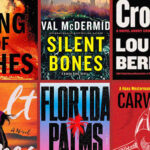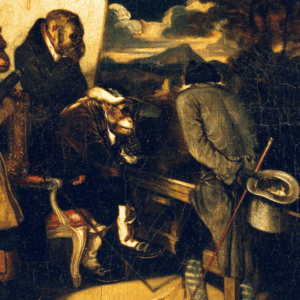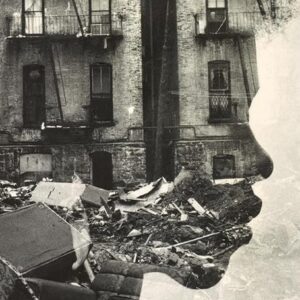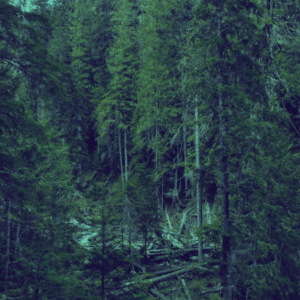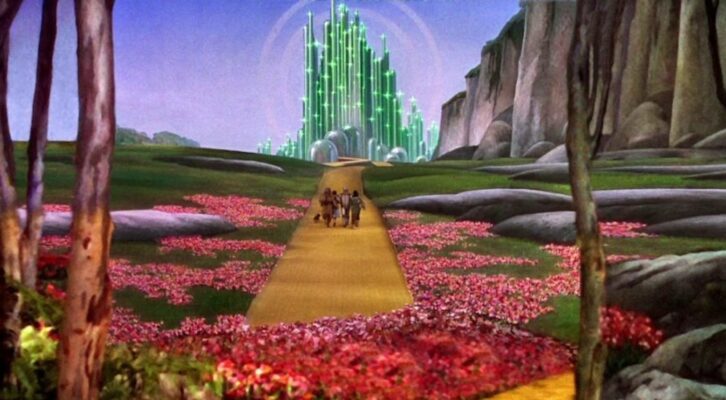
Why America Can’t Get Enough of The Wizard of Oz
Hazel Gaynor Celebrates the Films, Prequels, Sequels, and More
The MGM lion roars. Dramatic musical notes reminiscent of pealing bells ring out as the words The Wizard of Oz appear on the screen in looping text. Mesmerizing choral voices evoke the swirl and sway of wind and something other-worldly as we fly through a sepia cloud-filled sky. For ninety glorious seconds, while an orchestral medley teases the musical numbers yet to come, the opening credits roll before we cut to a young girl running along a farm track, a dog at her heels. What happens next is enshrined in Hollywood and movie history, and the lurching terror and hope we experience with Dorothy along the Yellow Brick Road will, for many of us, become a core memory.
Victor Fleming’s 1939 movie is most people’s introduction to The Wizard of Oz, and our most familiar version of L. Frank Baum’s characters. But this was not the first adaptation of Baum’s book, nor would it be the last. On publication of The Wonderful Wizard of Oz in 1900, some 10,000 copies were printed, but Baum’s publisher, George W. Hill, doubted the book’s potential for success. A stage adaptation of The Wizard of Oz, written as a musical extravaganza to suit an adult audience, was developed to help with publicity.
The first performance took place at the Chicago Grand Opera House in June 1902, and by 1903 had moved on to Broadway where it ran for nearly 300 performances before touring throughout America for almost a decade. Baum’s fairytale was well on its way to becoming an intrinsic part of American pop culture. Yet The Wonderful Wizard of Oz has had its challenges. Banned in 1957 by Detroit libraries, Baum’s book became a source of controversy again in 1986 when it was deemed unsuitable by school governors in Tennessee. Yet Dorothy and her friends weathered the storm and the American Library of Congress would ultimately declare the book to be ‘America’s greatest and best-loved homegrown fairytale.’
From the first printed edition, and the first musical adaptation, Dorothy’s adventures in Oz have been recreated numerous times, most famously with the 1939 movie starring Judy Garland. At the time of the film’s release, a million copies of Baum’s The Wonderful Wizard of Oz had been sold and, in response to demand from his young readers, he’d even written thirteen Oz sequels up to the year of his death in 1919. From the outset, the Oz books seem to have left many questions unanswered, so it is perhaps no surprise that the story has continued to reach audiences in new and varied formats on screen, stage, and page.
At the time of the film’s release, a million copies of Baum’s The Wonderful Wizard of Oz had been sold and, in response to demand from his young readers, he’d even written thirteen Oz sequels up to the year of his death in 1919.
For novelists, Baum’s characters and settings offer a tantalizing world to explore and expand and many literary works inspired by The Wizard of Oz have become huge bestsellers. Gregory Maguire’s Wicked: The Life and Times of the Wicked Witch of the West is arguably the most successful. Maguire’s inspiration for the book came from a line in the MGM movie where the Wicked Witch refers to The Good Witch of the North as ‘Glinda’. “I thought to myself, ‘They know each other. They’ve crossed paths before. They went to school together!'” Wicked, and a green baby called Elphaba, were born. Maguire’s origin story even has its own prequel now in this year’s release of Elphie.
Other literary spin offs have also proven popular. Elizabeth Letts explores the making of the 1939 movie and Maud Gage Baum’s role in managing her husband’s legacy in Finding Dorothy. Danielle Page’s NYT bestselling Dorothy Must Die series imagines a deliciously sinister turn of events in Oz, while Children’s Laureate, Sir Michael Morpurgo, presents the Oz story from Toto’s POV in, you guessed it, Toto. In my novel Before Dorothy, I imagine the life of Auntie Em as she raises Dorothy in Kansas during the dust bowl years.
And all the while, the original story endures. Walk into any bookshop and you’ll find at least one edition of Baum’s book. For Oz devotees and collectors, there are countless clothbound classics, mesmerizing pop-up books, and an annotated text by Michael Patrick Hearn—a fascinating archive for anyone looking for a line-by-line deep dive into Baum’s inspirations and themes.
The beauty and brilliance of Baum’s story is undoubtedly in its timeless power to stir an emotional response in us as adults. Like Laura Ingalls Wilder’s Little House stories, J.M Barrie’s Peter Pan, or Lucy Maud Mongomery’s Anne of Green Gables, once read, these tales become part of us, forever linking us back to the wide-eyed child of our first encounter. Like a scent with the ability to transport us back to a moment in time and place, the best stories have that same transportive power. Perhaps it is not The Wizard of Oz itself that pulls us back time and again, but the memory it evokes of who we once were.
Off the page, Oz has inspired musicals and movies. The Wiz debuted on Broadway in 1974, setting the story in modern African-American culture, with the 1978 movie adaptation starring Michael Jackson and Diana Ross. Return to Oz brought Dorothy’s controversial electric-shock treatment and the terror of the wheelies to movie-goers in 1985. Stephen Schwartz and Winnie Holzman’s lavish musical adaptation of Wicked opened on Broadway in 2003, with last year’s cinematic adaptation starring Ariana Grande and Cynthia Eviro bringing Oz roaring back to life once again. Wicked: (Part One) has attracted a new generation of Oz fans while also inviting Oz devotees to step back into a world that is so familiar, and yet so new.
Watching Wicked on the big screen evokes almost overwhelming feelings of nostalgia for those of us who have loved these characters for decades, the Oz Easter eggs John M. Chu sprinkles among his scenes like treasure; little gifts that whisper, “I know you know.”
Beyond the adaptations, sequels and prequels–oh my!–there are regular anniversary showings of the 1939 movie, countless re-recordings of Over the Rainbow, Oz theme parks and conventions. A digitally adapted version of the MGM movie will be shown at the Las Vegas Sphere this summer, utilizing AI technology. Controversial or inevitable, it will no doubt be a huge success as this most famous version of a beloved fairytale captures our imaginations still.
From Judy Garland’s pitch-perfect portrayal of Dorothy Gale, to the unforgettable songs, and the evergreen themes of friendship, good versus evil, courage and fear, family and home, such is our familiarity with the movie that its songs and quotes have stepped off the screen and into our hearts and voices. How often do we say, ‘There’s no place like home’, ‘I’ll get you my pretty’, ‘We’re not in Kansas anymore’, and who doesn’t yell, ‘Dorothyyyyy! Dorothy!’ in the middle of a storm, mimicking Auntie Em’s panicked cries!
Baum introduced his book to young readers as ‘a modernized fairy tale, in which the wonderment and joy are retained and the heartaches and nightmares are left out’. The fairytale has now become folklore. Few things last a lifetime, but The Wizard of Oz has already lasted many. Whether a new favorite, or a dear old friend, it is, quite simply, wonderful.
_____________________
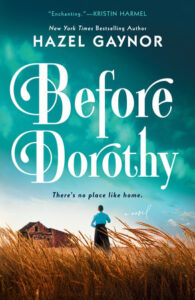
Hazel Gaynor’s Before Dorothy is available now from Berkley.
Hazel Gaynor
Hazel Gaynor is an award-winning, New York Times, USA Today, Irish Times, and internationally bestselling author known for her deeply moving historical novels which explore the defining events of the 20th century. The Last Lifeboat, was a Times historical novel of the month, an Audie award winner, and was short-listed for the Irish Book Awards. Her work is published in twenty-seven territories to date. She lives in Ireland with her family.









